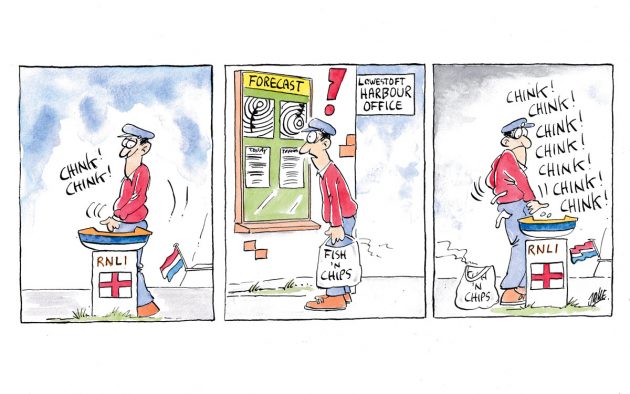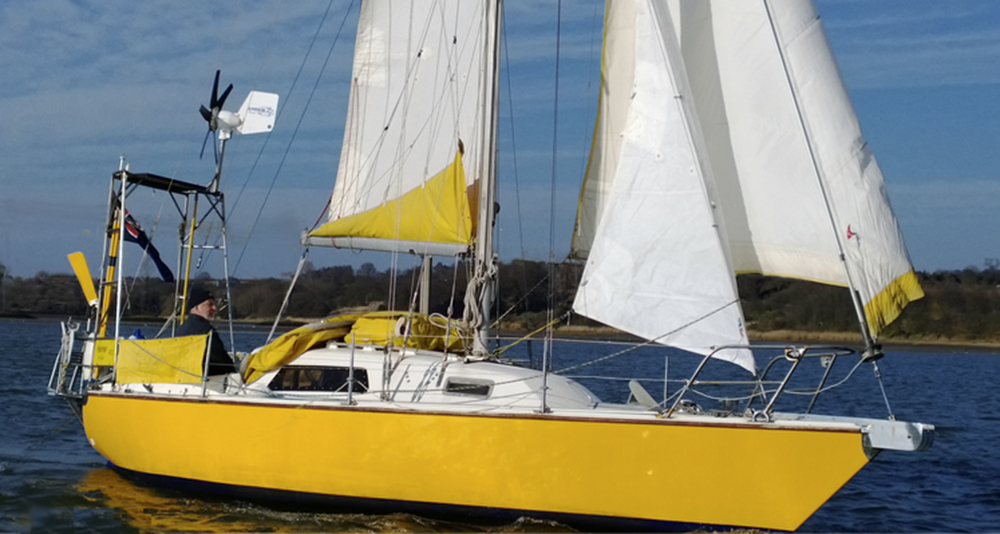With Covid and Brexit bureaucracy melting away, Saskia Groen-in’t-Woud enjoyed her first North Sea sailing experience – despite rough return weather
North Sea sailing from the Netherlands to the UK is a bucket list item for my sailing friend Wim and I – one, though, that has constantly been thwarted by Covid-19.
With so much travel uncertainty we’d given up on the idea and instead had a week organised at the beginning of August 2021 to sail the Standing Mast Route of the Netherlands and then a little jaunt to Belgium.
Suddenly, though, two days before we left, good old Boris appeared advising that people could travel to the UK again!
With a short diversion to pick up the Imray charts and get a PCR test, we followed the Standing Mast Route to Rotterdam and then, on 3 August, headed off on a glorious North Sea sailing adventure to the UK.
It was absolutely perfect and one of the best night sails I have ever done. Shooting stars left glittering vapour trails as they plummeted into our atmosphere and it was easy to spot constellations.
We both got good sleep on our off watches as my Swan 38, Céleste, happily burbled along in a steady 10-15 knot southerly beam reach. Bliss!

Swan 38 Céleste moored up at Lowestoft after her North Sea sailing debut
Checking in
Given Brexit and Covid, we weren’t too sure what processes to expect as a Dutchman and an Australian, but we at least prepared ourselves.
Passenger locator forms were submitted to the Royal Norfolk and Suffolk Yacht Club, our Day 2 Covid tests booked, form C1331 downloaded and filled in and the National Yachtline Hotline number in hand.
For all the uncertainty about the process, it was beautifully smooth and we felt so welcome as we called in and spoke to the Hotline and Border Force.
My Aussie passport was cleared for immigration quickly and we tied up with a breakfast beer in Lowestoft feeling pretty happy about the whole experience.
Kudos to the UK, because this was far easier than anticipated!
Lowestoft is a welcoming place and we enjoyed the walk south, following the quiz guide the Yacht Club had prepared at reception.
Though tired, we found an ice cream in the warm sunshine cures all fatigue and just hearing English speaking voices again for me was wonderful.
We made our way back to Céleste with a big armful of fish and chips and sat in the cockpit sunshine enjoying the crowds wandering around in the early evening.

Wim and Saskia enjoy a beer in the Lowestoft sunshine
Storm warning
While idly enjoying a glass of wine we took a look at the weather forecast only to see, with dismay, that the system we were expecting on Sunday had sped up and was now arriving two days early.
We had to leave in the morning to make it back to the Dutch side before the weather really closed in for four days – and so I could put one of my sons on the plane with his mates for his holiday.
Sailing holidays when non-sailing family is at home is always a bit of a juggle.
We cast off at 0930 Thursday morning in a brisk 15 knots and headed out the south entrance, set sails and were away!
We cruised along at a steady 7+ knots for hours enjoying sunshine and absolutely perfect North Sea sailing conditions.
But we also knew this would be short lived and as darkness started to roll in, we prepared for the heavier forecast conditions by reefing the main and headsail.
Article continues below…
Yachtsman airlifted from North Sea with hypothermia
The yacht was taking on water, its sails were in tatters and the engine had failed amid 46mph gusts of…
7 Storm Jibs on test
We test 7 storm jibs, including wrap around and sleeved sails, to find out the best options for your boat
Yachtsman Julian Mustoe: “I’m distressed about losing my boat”
"Just about everything I owned is now at the bottom of the North Sea" says yachtsman Julian Mustoe.
A turn for the worse
As we neared the Dutch side of the North Sea, the weather turned nasty and instead of 14-21 knots as forecast, we saw 25-35 knots consistently for the next eight hours.
Céleste handled herself beautifully despite being a bit over canvassed and we hit boat speeds of 8.8 knots quite often.
Aside being told to go away by a few oil platforms, and realising that getting older means eyesight can’t read the night setting on the plotter – especially when glasses are useless in blinding rain – we made a beeline for IJmuiden and as dawn broke, were pretty happy to see it.
Outside the sea wall, we furled the headsail in 25 knots and prepared the boat to enter the rolling swells that always build in this area.
But suddenly all 135% of my overlapping headsail dramatically unrolled itself with a giant ship behind us and a lot of wind.
Things were getting hairy.

A spirited North Sea sailing experience
Realising the furling line had come out of the furler brace, we went for the manual drop.
Not wanting to engage the engine with sheets flogging and a mild bit of chaos, I put Céleste head to wind and sheeted in the main while Wim battled his way forward and wrestled this enormous sail to the deck.
A sudden gust and big wave caught the sail and about a third of it went overboard – a pretty hideous situation.
With Céleste sitting herself into the wind surprisingly well, I ran forward and it was a team effort to get the sail back on deck and lashed down.
This is when you wish you had more crew!
North Sea sailing: Was it worth it?
Once the boat was under control, we had a moment to catch our breath and then head for the first breakwater wall.
A bit of lively surfing in a displacement boat always sharpens your helming skills – 9 tons broaching towards rocks is not a desired outcome.
Once inside, thankfully all was calm and we dropped the main, quietly crept into the windy Ijmuiden morning, tied up and promptly fell asleep.
We literally made a 260-mile journey in two and a half days just for Lowestoft fish and chips.
Was it worth it? Absolutely!
TIPS FOR UK BOAT OWNERS SAILING TO EUROPE
- Remember that the boat and the person are regarded entirely separately. People are covered by immigration rules, the boat is governed by customs rules.
- EU-wide travel is governed by the Schengen Agreement, which allows 90 days of travel in every 180-day period. UK visitors do not require a visa for Europe, but must still comply with this rule. Over-staying is a serious matter and likely to incur severe fines.
- The main rules for boats are limited to the ‘tax status’ of the vessel. Any non-EU vessel may be temporarily imported for a period of up to 18 months before becoming liable to VAT.
- Most countries will issue a ‘transit log’ to be kept with the vessel while it is in that country. This must be stamped on leaving the country, and a new one obtained at the new country’s port of entry.
- The Royal Yachting Association (RYA) recommends that recreational boaters with marked ‘red’ diesel purchased in the UK keep receipts to prove where it was bought and request that your retailer marks them ‘duty paid’. Log the date of refuelling and engine hours run since then to reinforce these records, and do not carry marked diesel anywhere other than in your craft’s main fuel storage tanks. For other useful information visit the RYA website rya.org.uk
If you have a short adventure to share email pbo@futurenet.com and if we publish you’ll get to keep the original Jake Kavanagh cartoon.







